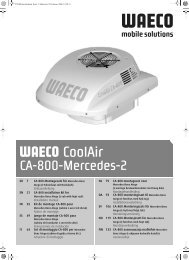waeco
Create successful ePaper yourself
Turn your PDF publications into a flip-book with our unique Google optimized e-Paper software.
CA-800-Install.book Seite 22 Mittwoch, 20. Februar 2008 12:28 12<br />
Safety instructions<br />
1.1 Using the device<br />
CoolAir<br />
• Only use the roof air conditioner for the purpose specified by the<br />
manufacturer and do not make any alterations or structural changes to<br />
the device.<br />
• Only operate the roof air conditioner if you are certain that the housing<br />
and the cables are not damaged.<br />
• The roof air conditioner must be installed safely so that it cannot tip over<br />
or fall down.<br />
• Installation, maintenance and repair work may only be carried out by<br />
qualified personnel from a specialist company who are familiar with the<br />
risks involved and the relevant regulations.<br />
• Do not use the roof air conditioner near flammable fluids or in closed<br />
rooms.<br />
• Do not reach into air grilles or ventilation nozzles or insert any foreign<br />
objects in the system.<br />
• Do not undo the upper cover of the roof air conditioner in the event of a<br />
fire. Use approved extinguishing agents instead. Do not use water to<br />
extinguish fires.<br />
• Switch off the roof air conditioner before you use automatic washing<br />
equipment (car washes, etc.) to clean the car!<br />
• Please ask your vehicle manufacturer if the height entered in your<br />
vehicle documents needs to be altered due to the extra height of the air<br />
conditioning roof unit (extra height 209 mm).<br />
• Disconnect all connections to the battery when carrying out work on the<br />
device!<br />
• Always manually drain the condensation from the system before<br />
maintenance or tilting the cab (see the section on draining the<br />
condensation in the operating manual for the CoolAir CA-800).<br />
1.1.1 Handling electrical cables<br />
• Use cable ducts to lay cables through walls with sharp edges.<br />
• Do not lay loose or bent cables next to electrically conductive materials<br />
(metal).<br />
• Do not pull on the cables.<br />
• Attach and lay the cables in such a manner that they cannot be tripped<br />
over or damaged.<br />
• The electrical power supply may only be connected by a qualified<br />
electrician.<br />
• Fit a fuse of at least 25 amps to the connection with the vehicle's power<br />
supply.<br />
• Never lay power supply lines (battery leads) in the vicinity of signal or<br />
control wires.<br />
22



